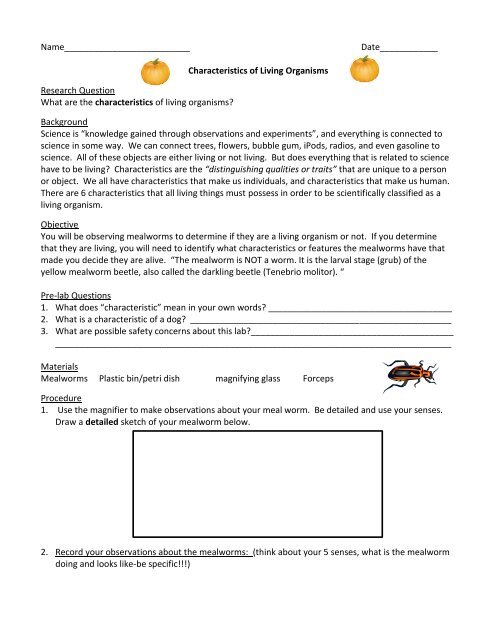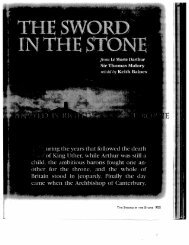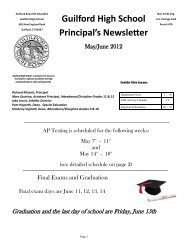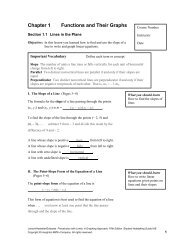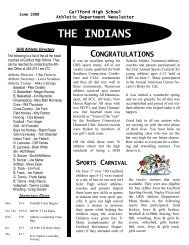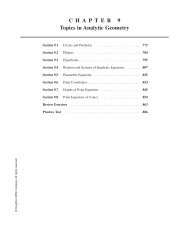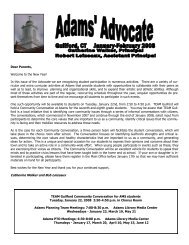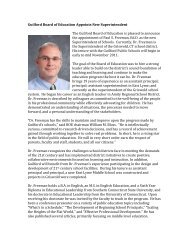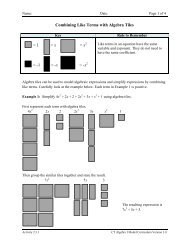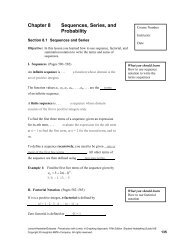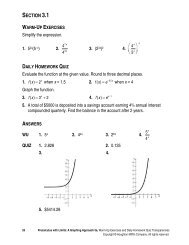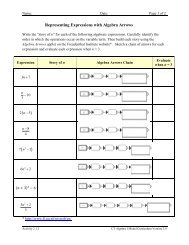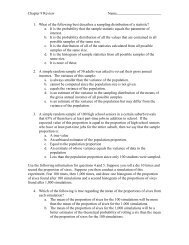Mealworm Lab/Activity
Mealworm Lab/Activity
Mealworm Lab/Activity
Create successful ePaper yourself
Turn your PDF publications into a flip-book with our unique Google optimized e-Paper software.
Name__________________________<br />
Date____________<br />
Research Question<br />
What are the characteristics of living organisms?<br />
Characteristics of Living Organisms<br />
Background<br />
Science is “knowledge gained through observations and experiments”, and everything is connected to<br />
science in some way. We can connect trees, flowers, bubble gum, iPods, radios, and even gasoline to<br />
science. All of these objects are either living or not living. But does everything that is related to science<br />
have to be living? Characteristics are the “distinguishing qualities or traits” that are unique to a person<br />
or object. We all have characteristics that make us individuals, and characteristics that make us human.<br />
There are 6 characteristics that all living things must possess in order to be scientifically classified as a<br />
living organism.<br />
Objective<br />
You will be observing mealworms to determine if they are a living organism or not. If you determine<br />
that they are living, you will need to identify what characteristics or features the mealworms have that<br />
made you decide they are alive. “The mealworm is NOT a worm. It is the larval stage (grub) of the<br />
yellow mealworm beetle, also called the darkling beetle (Tenebrio molitor). “<br />
Pre-lab Questions<br />
1. What does “characteristic” mean in your own words? ______________________________________<br />
2. What is a characteristic of a dog? ______________________________________________________<br />
3. What are possible safety concerns about this lab?__________________________________________<br />
__________________________________________________________________________________<br />
Materials<br />
<strong>Mealworm</strong>s Plastic bin/petri dish magnifying glass Forceps<br />
Procedure<br />
1. Use the magnifier to make observations about your meal worm. Be detailed and use your senses.<br />
Draw a detailed sketch of your mealworm below.<br />
2. Record your observations about the mealworms: (think about your 5 senses, what is the mealworm<br />
doing and looks like-be specific!!!)
Observation/Conclusion Questions-Please answer in COMPLETE sentences<br />
1. Adaptations are physical features (body structures) or behaviors that allow an organism to survive.<br />
Make a list of physical and behavioral adaptations that you can observe:<br />
Physical Adaptations (Body Structures)<br />
Behavioral Adaptations (What they do)<br />
2. What characteristics make the mealworm so unique from other organisms?<br />
3. What needs to the mealworms have in order to survive?<br />
4. How do you know the mealworms are a living organism and that they are alive?<br />
5. You should have noticed that the mealworm responds to its surroundings and environment. The<br />
condition that causes the response is called a STIMULUS. In Part Two of this investigation, you will<br />
design an experiment to observe the effect of changes in the environment (stimuli) on the behavior<br />
(responses) of the mealworm. List all of the possible conditions that you think you could safely<br />
change and investigate (without harming the mealworms)?<br />
(hints: food, light, texture, scents, surroundings )<br />
What can you change? (IV)<br />
What can you observe? (DV)<br />
6. After discussing this as a class, choose the one condition (stimuli) that you will test as a group<br />
What we will change<br />
What we will observe<br />
7. What materials will you need? Tell your teacher what you will be able to bring in, or what you will<br />
need. (design how you will set up your bin with the mealworms in it)
Name_____________________________________<br />
Date______________________<br />
Meal Worm <strong>Lab</strong> Investigation<br />
Research Question<br />
What are the characteristics of living things?<br />
Objective<br />
Today you will investigate the one condition you chose to observe how your mealworms respond.<br />
What we will change<br />
What we will observe<br />
Procedure:<br />
Write a step by step procedure for how you will test your stimuli on the mealworms:<br />
Observations<br />
Stimulus<br />
Response<br />
OVER
Name______________________________________<br />
Date________________________<br />
<strong>Mealworm</strong> Investigation Summary<br />
Create a summary of your team's mealworm investigation. You may create a mini-poster on normal<br />
white unlined computer paper, or you may write a brief essay. Posters should have images and<br />
descriptions. You MUST include the terms stimulus and response. Your summary must respond to the<br />
following:<br />
•What environmental conditions did your group change? What was the stimulus that you<br />
tested?<br />
•Summarize the way that you set up your test (inside your bin) to determine how a mealworm<br />
would respond to that condition.<br />
•What behaviors (responses) did the mealworms demonstrate?<br />
Descrive How do y<br />
•What evidence, if any, do you have that mealworms respond to stimuli in their environment?<br />
What characteristics do the mealworms have to prove they are a living organism?<br />
Rubric<br />
Requirement Points Possible Points Earned<br />
Condition changed-stimuli 4<br />
How stimuli was tested 4<br />
Responses of mealworm 4<br />
Detailed (words or drawing) 4<br />
<strong>Lab</strong>els/Neat/Clear 4<br />
Totals 20
Name__________________________<br />
Date____________<br />
Research Question<br />
What are the characteristics of living things?<br />
Characteristics of Living Things**<br />
Background<br />
We have learned that science is “knowledge gained through observations and experiments”, and that<br />
everything is connected to science in some way. We can connect trees, flowers, bubble gum, iPods,<br />
radios, and even gasoline to science. All of these objects are either living or not living. But does<br />
everything that is related to science have to be living? Characteristics are the “distinguishing qualities<br />
or traits” that are unique to a person or object. We all have characteristics that make us individuals,<br />
and characteristics that make us human. There are 6 characteristics of living things that all living things<br />
must possess in order to be scientifically classified as living.<br />
Objective<br />
You will be observing mealworms to determine if they are a living organism or not. If you determine<br />
that they are living, you will need to identify what characteristics or features the mealworms have that<br />
made you decide they are alive. “The mealworm is NOT a worm. It is the larval stage (grub) of the<br />
yellow mealworm beetle, also called the darkling beetle (Tenebrio molitor). “<br />
Materials<br />
<strong>Mealworm</strong>s Plastic bin Forceps<br />
Procedure<br />
1. Use the magnifier to make observations about your meal worm. Be detailed and use all your<br />
senses. Draw a sketch of your mealworm below.<br />
Observations (think about your 5 senses, what is the mealworm doing and looks like-be specific!!!)<br />
Color:<br />
Texture:<br />
Shape:<br />
Movement:<br />
Observation/Conclusion Questions-Please answer in COMPLETE sentences<br />
1. What characteristics make the mealworm so unique from other organisms? (Hint:shape, texture)
2. Adaptations are physical features (body structures) or behaviors (movement/activities) that allow an<br />
organism to survive. Make a list of physical and behavioral adaptations that you see:<br />
Physical Adaptations (Body Structures they have) Behavioral Adaptations (What they do/how they move)<br />
3. What do the mealworms need in order to survive? (hint: think about what you need!)<br />
4. How do you know mealworms are a living organism? (Hint: what characteristics do they have?)<br />
5. You should have noticed that the mealworm responds to its surroundings and environment. The<br />
condition or change that causes the response is called a STIMULUS. In Part Two of this investigation,<br />
you will design an experiment to observe the effect of changes in the environment (stimuli) on the<br />
behavior (responses) of the mealworm. List some of the possible conditions that you think you<br />
could safely change and investigate (without harming the mealworms).<br />
(hints: food, light, texture, scents, surroundings )<br />
What can you change? (IV)<br />
What can you observe? (DV)<br />
6. After discussing this as a class, choose the two conditions (stimuli) that you will test as a group<br />
What we will change (IV)<br />
What we will observe (DV)<br />
7. What materials will you need? Write down and tell Miss Meyerjack what you will be able to bring in,<br />
or what you will need.<br />
8. What are the safety concerns of this lab? What will you need to do in order to maintain safe<br />
conditions?<br />
Name_____________________________________<br />
Date______________________
Research Question<br />
What are the characteristics of living things?<br />
Meal Worm <strong>Lab</strong> Investigation<br />
Objective<br />
Today you will investigate the two conditions you chose to observe how your mealworms respond.<br />
What we will change<br />
What we will observe<br />
Procedure: write a step by step procedure for how you will test your stimuli on the mealworms<br />
(you can use a separate sheet of paper)<br />
Observations<br />
Stimulus<br />
Response<br />
Name______________________________________<br />
OVER<br />
Date________________________
<strong>Mealworm</strong> Investigation Summary<br />
Create a summary of your team's mealworm investigation. You may create a mini-poster on normal<br />
white unlined computer paper, or you may write a brief essay. Posters should have color images and<br />
descriptions. You MUST include the terms stimulus and response. Your summary must respond to the<br />
following:<br />
•What environmental conditions did your group change? What was the stimulus that you<br />
tested?<br />
•Summarize the way that you set up your test to determine how a mealworm would respond to<br />
that condition.<br />
•What behaviors (responses) did the mealworms demonstrate?<br />
•What evidence, if any, do you have that mealworms respond to stimuli in their environment?<br />
What characteristics do the mealworms have to prove they are a living organism<br />
Rubric<br />
Requirement Points Possible Points Earned<br />
Condition changed-stimuli 4<br />
How stimuli was tested (what did you do) 4<br />
Responses of mealworm 4<br />
Detailed (words or drawing) 4<br />
<strong>Lab</strong>els/Neat/Clear 4<br />
Totals 20


